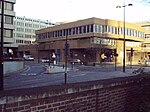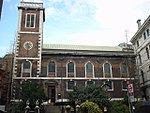Blackfriars Pier
Buildings and structures celebrating the third millenniumLondon River ServicesLondon building and structure stubsLondon transport stubsPiers in London ... and 2 more
Transport in the City of LondonUse British English from February 2017

Blackfriars Pier is a pier on the River Thames, in the Blackfriars area of the City of London, United Kingdom. It is served by boats operating under licence from London River Services and is situated on the north bank of the Thames, adjacent to Blackfriars Bridge. Blackfriars Millennium Pier is a major transport interchange being close to Blackfriars rail and tube station, providing direct interchange with Thameslink and South Eastern rail services, and with the London Underground Circle and District Lines. The Pier is seen predominantly as a commuter pier and thus is not typically served by River Bus services during weekend and bank holiday periods.
Excerpt from the Wikipedia article Blackfriars Pier (License: CC BY-SA 3.0, Authors, Images).Blackfriars Pier
Blackfriars Pier, City of London
Geographical coordinates (GPS) Address Nearby Places Show on map
Geographical coordinates (GPS)
| Latitude | Longitude |
|---|---|
| N 51.5107 ° | E -0.1017 ° |
Address
Blackfriars Pier
Blackfriars Pier
EC4V 3DB City of London
England, United Kingdom
Open on Google Maps









